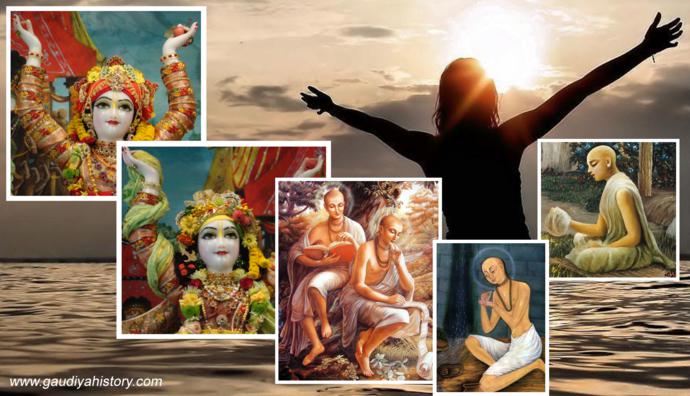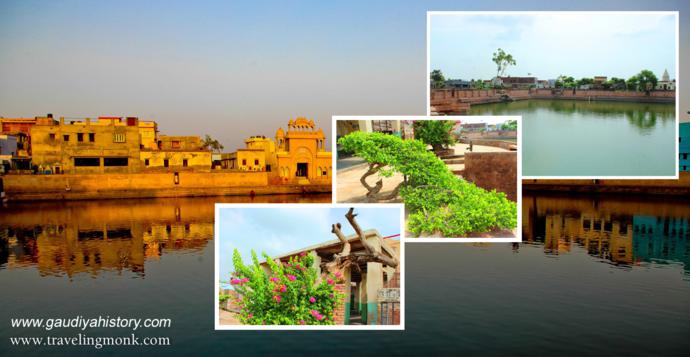Shri Raghunatha dasa took his birth in the village of Shri Krishnapura in the district of Hooghly. His father's name was Shri Govardhana, whose elder brother was Shri Hiranya dasa. Both of them were respectable wealthy land-holders belonging to the Kayastha caste. Their title, which was given by the King, was "Majumdar".
In his childhood Shri Raghunatha dasa studied at the house of the priest, Acharya Shri Balarama dasa. Haridasa Thakura was very merciful to Balarama dasa and occasionally visited his house. At these times Raghunatha dasa had the good fortune of relishing Thakura Haridasa's association and listened to philosophical discourses from him.
Shri Raghunatha dasa was the only son in the family of Hiranya and Govardhana and there was no limit to the care and affection which was showered upon him. Though he was brought up just like the son of a king, by the powerful influence of saintly Devotees, he realized at a very young age that material existence is temporary and a mood of detachment towards wealth, parents and relatives began to grow within him.

Shri Raghunatha dasa was the only son in the family of Hiranya and Govardhana and there was no limit to the care and affection which was showered upon him. Though he was brought up just like the son of a king, by the powerful influence of saintly Devotees, he realized at a very young age that material existence is temporary and a mood of detachment towards wealth, parents and relatives began to grow within him. (In the wallpaper: from left to right Shri Vijaya Gauranga, Shri Nityananda Prabhu, ISKCON Hungary, Shri Rupa and Shri Sanatana Goswamis, Shri Raghunatha Das Goswami, Shrila Haridas Thakur).
Upon hearing the glories of Shri Gauranga and Nityananda, he became extremely eager to have darshana of Their lotus feet. When he heard that Shri Gaurasundara had taken sannyasa and was leaving Nadia forever, he rushed madly to the home of Advaita Acharya in Shantipura to meet the Lord. Seeing Raghunatha fall at His feet, Shri Chaitanya Mahaprabhu could understand that this was His dearmost eternal associate, and He embraced Raghunatha firmly. Crying, Shri Raghunatha appealed to the Lord, "I will also go with you." But the Lord replied that He would not take him along at that time, yet upon His return from Vrindavana, Raghunatha should, under any pretext, come to Nilachala to see Him.
In CC Antya lila, Sixth Chapter, there is a narration of how Shri Raghunatha dasa was arrested by the Nawab's men and his subsequent release from the bondage of family life. In that chapter there is also a description of the Panihati festival, as well as Raghunatha's pastimes in Jagannatha Puri with Shri Gaurasundara.
Shri Raghunatha dasa Goswami passed his days in the highest happiness, continually bathing in the shower of Mahaprabhu's mercy. But upon the disappearance of Shri Chaitanya Mahaprabhu, Raghunatha's world grew dark. In separation from their Lord, the Devotees' hearts burned with anguish. Raghunatha dasa also burned in that fire of separation, but taking the order of Mahaprabhu on his head, he went to Shri Vrindavana. Previously Shri Sanatana, Shri Rupa, Shri Gopala Bhatta, Shri Raghunatha Bhatta, Shri Lokanatha, Shri Kashishvara, and Shri Bhugarbha Goswami had already gone to Vrindavana and were living there by the order of the Lord. Though they all burned in the fire of separation, they pacified themselves by gathering together and discussing and writing the conclusions of the teaching of Mahaprabhu. It was the dawn of a golden age in Vraja. Shri Vallabha Acharya also visited Vrindavana at that time.
Shri Raghunatha used to reside at Shri Radha kunda. At that time Radha kunda had not yet been excavated, though Raghunatha often meditated upon how to beautify the kunda. Once a wealthy merchant walked the long, difficult road to Shri Badarik ashrama. With great devotion he worshiped Shri Badarinarayana and offered a large portion of his wealth in charity. That night Shri Badarinarayana appeared to him in a dream and said, "You should go to the village near Vraja named Arit-grama where you will find my Devotee, Shri Raghunatha dasa Goswami. To him you should deliver all your wealth. If he refuses to accept it, tell him I sent you and remind him about restoring Radha kunda." The merchant happily returned to his home and then went on to Vraja where he met Shri Raghunatha and explained everything to him. Astonished, Raghunatha gave him permission to restore both Radha kunda and Shyama kunda.
On the banks of the kunda grew five trees, which were actually the five Pandavas. Once there was some talk of cutting the trees down, but that night the Pandavas appeared to Raghunatha and forbade the trees to be cut. To this day the trees still grow there. The Devotees were overwhelmed with happiness to see the restoration of Shri Radha kunda and Shri Shyama kunda. On the outskirts of these two ponds, groves of the Asta-sakhis were planted.

On the banks of the kunda grew five trees, which were actually the five Pandavas. Once there was some talk of cutting the trees down, but that night the Pandavas appeared to Raghunatha and forbade the trees to be cut. To this day the trees still grow there. The Devotees were overwhelmed with happiness to see the restoration of Shri Radha kunda and Shri Shyama kunda. (In the wallpaper: from right to left Shyama Kund, Arjuna tree, Bhima tree, background image is Radha Kund, Vrindavan).
Raghunatha did not have a fixed residence, but stayed either on the banks of Shri Radha kunda or on the banks of the Manasa Ganga. At that time both places were surrounded by a fearful jungle inhabited by ferocious tigers and other wild beasts. One day Shri Sanatana Goswami arrived at the bhajan kutir of Shri Gopala Bhatta Goswami on the banks of the Manasa Ganga where he would take his midday meal. When going for a bath at Pavan Ghat he saw a tiger very nearby who had just drunk water in the ghat. Just a little further on, Raghunatha dasa sat at the base of a tree deeply absorbed in his bhajan. Sanatana Goswami was alarmed and requested Raghunatha to practice bhajan in a cottage or hut. From that day on Raghunatha performed his bhajan in his hut.
Raghunatha dasa Goswami was always engaged in worshiping Shri Radha-Govinda within his mind. One day, in his meditation he prepared and offered sweet-rice to Shri Radha and Krishna. In great happiness They and the gopis ate the sweet rice, and he accepted Their remnants. While he was honoring their Lordship's Prasada, he was filled with intense love and ate slightly more than what he was accustomed to. The next day, from morning until late afternoon his door remained closed, causing the Devotees some concern. After they knocked repeatedly on his door, it finally opened and they saw him lying down. "My health is not good," he explained to Shridasa. The Devotees were unhappy and immediately sent word to Sanatana Goswami in Mathura. At that time Shri Sanatana was staying at the house of Vallabha Acharya. Upon hearing the news, Vallabhacharya's son, Shri Viththal, sent two doctors to see Raghunatha dasa at Radha-kunda.
Seeing his condition the physicians insisted that Raghunatha's illness was the result of eating too much sweet rice. The Devotee were dumbfounded by such a suggestion, but eventually understood the mystery. The worship of Raghunatha dasa Goswami was very wonderful.
Kavi Karnapura has written in Gaura-ganoddesha-dipika (186) that Shri Raghunatha was Rasamanjari in Krishna lila. According to some other persons he was Ratimanjari or Bhanumati.
Raghunatha dasa wrote many books such as: Stavavali, Danacharita, Muktacharita, etc. He also composed many padas. He was born in the Saka era of 1428 and left the world in the Saka era of 1504, on the twelfth day of the bright fortnight in the month of Ashvina. (CC 1.10.91-102, 3.6.35-154, Gaura-ganoddesha-dipika 186, Premavilasa 16.127)
His name has been mentioned in the following texts: Vaishnava Vandana of Jiva Goswami (149-150), of Devakinandana (55), and of Vrindavana dasa (49); Krishna Chaitanya charitam of Murari Gupta 4.17.21; Karnapura's Chaitanya Chandrodaya Nataka 10.3.; CC (R.G. Nath ed.) 2.1.269.